
| Print | Back |  |
October 10, 2012 |
 |
Rambling Thoughts on Church History Time Out for Golfby James B. Allen |
Yes, LDS golfers, you can rest assured that the grand old Scottish game is a part of our history! And since I started writing this column the same week that the Ryder Cup was going on, and finished it the week of General Conference, I could hardly resist the temptation to do a little historical flashback on what Church leaders were doing about golf when it first came to Utah.
There was little if any golf in Utah until the Salt Lake Country Club was organized in 1899 and built Utah's first golf course. It was located in what is now the Gilmer Park Historic District. The first Utah Amateur Tournament was staged there the year it opened. In 1905, the Country Club moved to Forest Dale, opening what is now the oldest golf course in Utah. The Country Club relocated again in 1920, building another new golf course. Forest Dale was acquired by the city in 1935.
Perhaps the first General Authority to take up golf was Charles W. Nibley, who was born in Scotland, the home of golf, in 1849. His family had been converted to the Church five years earlier. They emigrated to America in 1855, lived first in Rhode Island and then came to Utah in 1860. A prominent Utah business man, Charles was called to be the Presiding Bishop of the Church in 1907. He served in that capacity until 1925, when he became Second Councilor to President Heber J. Grant. He died in 1931.
Charles began to play golf about 1915, when he was 66 years old, and soon got the President of the Church, Joseph F. Smith, to join him. President Smith was in his late 70's at that time. "It has been something of a blessing to both of us, I think," he once wrote, "that during the last two or three years we have gotten acquainted in a small way at least, with the ancient and royal Scottish game of golf."
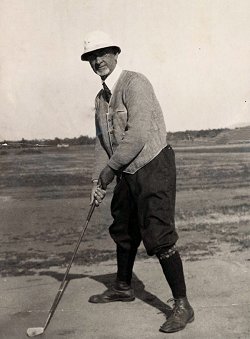
They both became members of the Salt Lake Country Club as well as the Brentwood Country Club in Santa Monica, California. In Santa Monica, Nibley once noted, "we have enjoyed many happy days together on the golf field, although our game was usually not of the best. Still the President has made the nine holes in forty-five as I remember, and I have done the same, although on the whole, I believe I could beat him at golf more often than I could beat him at checkers." This was a commentary on the fact that on their frequent ocean voyages together, to visit foreign missions, their chief diversion was playing checkers.1
But, of course, these Church leaders were hardly exempt from making the same blunders that most amateur golfers (at least those like me) do. Bishop Nibley told of an incident in Santa Monica when he was playing with President Smith and his son, Wesley. President Smith's ball ended up short of the green, but perhaps only about a hundred feet from the pin.
A short, easy stroke would have put the President in good position to get the next shot in the hole. However, he took his eye off the ball, topped it, and it rolled just a few feet. He tried again and the same thing happened. Apparently disgusted, the next time he "hit it with a whack" that sent it beyond the green and off the edge of the fairway.
Wesley said to his dad, rather loudly, "Why Papa, what did you hit it like that for? You knew it would go way down in the ditch. What did you do that for?" The President, "marching up toward it," replied rather forcefully, "I was mad at it."
As he grew older, Charles W. Nibley made frequent trips to Santa Monica for rest and recuperation. There golf was his chief diversion. Just before 9 o'clock each morning, he would show up at the Brentwood Golf Course. As a family member recalled, "he found all the enjoyment that it is possible for a lover of golf to have. We can all recall how disappointed he was when a rainy day came on, and he would be kept indoors. Occasionally he would go out to the course with his rubbers and raincoat on, and play through a storm. He was there for enjoyment and he was going to have it."
Writing in his reminiscences of his association with President Grant, he said that he firmly believed that their various trips together as well as the game of golf were the means "of benefitting him and myself also, and lengthening out our days in more of health and ability to work than we could possibly have done without them."
Bishop Nibley played at country clubs, but he was so gratified at what golf did for him, and so convinced that it could do the same for the general public, that he decided that there should be a public golf course in Salt Lake City. In 1921, he purchased a large property known as Wandamere Park and donated it to the city for the purpose of building that public course.
As a family member explained, he made the donation, "so that people of small means could find equal enjoyment with those who belonged to the exclusive country clubs." The deed stipulated that the land could never be sold, subdivided, or desecrated. When the golf course opened in the spring of 1922, President Heber J. Grant dedicated it and hit the first ball off the No. 1 tee.
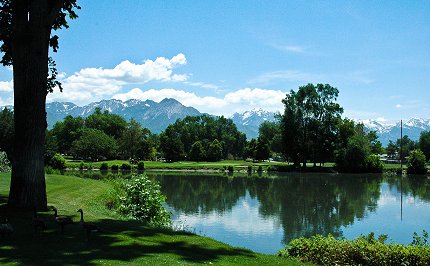
In a formal ceremony in May 1922, Bishop Nibley said: "When I think that this generation and the generations of men and women yet to come shall find healthful enjoyment and rare pleasure here in playing that splendid outdoor Scotch game known as golf, that thought gives me the highest satisfaction and most genuine pleasure." He also refused to allow a memorial to be erected in his honor, saying that the money could be better spent to "improve one of the greens."2 The City Commission, however, had already passed a resolution recognizing the gift, guaranteeing to maintain the park, and naming it in honor of the donor. Nibley Park thus became the first public golf course in the state.
Bishop Nibley's love for golf had a kind of snowball effect on at least some of the other General Authorities of his day. As we have already seen, one of his first converts to the game was President Joseph F. Smith, and he became as enthusiastic as the bishop. In fact, his taking it up actually drew national attention. The following item, along with a photo of President Smith playing golf, appears on page 30 of the January 1918 issue of Golfer's Magazine.
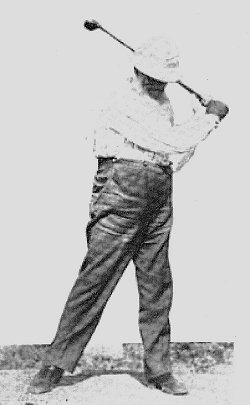
One of the late converts to golf is Joseph F. Smith, president of the Church of Jesus Christ of Latter Day Saints, better known as the Mormons. President Smith is seventy-nine years old, but every morning he boards his machine at Lion House, his home in Salt Lake City, and before breakfast at eight has gone round the course at the Country Club. Doing a couple of hours work after his lunch at noon, the Mormon leader finds time to play another round of golf at the Country Club.
"I have taken up the game," said President Smith," for exercise. I believe it is a wonderful outdoor sport, and I will admit it has a fascination that gives it spice. I don't believe the game violates any doctrines of my religion."
President Smith, in turn, introduced others to the game, such as his son Joseph Fielding Smith, a member of the Quorum of the Twelve. In August, 1916, the Church President asked his son to join him in Santa Monica. There Joseph Fielding helped his father with correspondence for a week. On August 26, he noted, "I spent the forenoon with my father writing letters, after which he, Wesley, and I went out and played golf. The first time I ever saw the game. My father seemed to enjoy it and is playing for the exercise he gets in the open air." Presumably Joseph Fielding played more than once.3
Joseph F. Smith's other converts included Heber J. Grant, senior member of the Quorum of the Twelve and, in 1918, President Smith's successor as Church president. Still another was George Albert Smith, a cousin to President Smith, an apostle, and successor to Heber J. Grant. He played his first game on November 27, 1917.
Heber J. Grant was perhaps Joseph F. Smith's most famous convert. He was a reluctant convert but, as so often happens with reluctant converts to anything (including the Church itself), he quickly became an enthusiastic and unwavering disciple. Like Bishop Nibley, Elder Grant was a hard-working and highly successful businessman who earlier in his career could see no value in taking time out for such a frivolous sport as golf.
The conversion began one day after Elder Grant walked into the president's office with a matter of pressing business, only to find that he was out golfing. Feeling that the matter at hand was so urgent that he had no time to wait, Heber hied himself to the golf course, tracked down the Church leader, and tried to present his business. Sensing that the apostle was somewhat upset, the president said "Heber, you are tense and overworked. You should learn to play this game!"
Heber was stunned. How could the president make such a suggestion when there was simply too much work to do and not enough time to finish it?
Probably smiling inside, the president went on: "Many times I, myself, get overworked, weary and so tense I can accomplish but little. So I drop everything and come play golf." In the end, he tried to assure Heber, playing golf actually made him more productive. "There is something about this game that relaxes me and causes me to forget my anxieties," he said. "When I get back to the office I can accomplish more in a few hours than I could in days when I am so tense."
Standing firm on his convictions, however, Heber replied: "You will never catch me wasting my time playing that silly game. Now sign these papers and let me get back to work."
"No, Heber," the president responded, "I will not sign a thing until you take my partner's club and finish out this round with me."
"Not on your life," said Heber. "I've got too much to do to fool away my time here."
At that point the President of the Church good-naturedly invoked his authority, in a way that the apostle could hardly refuse: "Heber, I command you to take that club and play out this round with me."
"Well," Heber replied, "if you are going to use your Priesthood on me I guess I'll have to."
The President then gave him a brief lesson, after which Heber took his first shot. As he described it later, "I swung at it -- I was very mad. I swung and knocked the ball a quarter of a mile down the fairway. Never since, in all my golf playing have I knocked a ball so far, and I have tried so hard and so many times to do it."
That first hit did not totally persuade him, but it was not long before he was an avid golfer. "After much persuasion by Pres. Smith and others, I took to playing golf and learned that Pres. Smith was right. Nothing I can do . . . relaxes me half as much as two hours on the golf course. I can return to the office and unravel problems that seemed unsolvable when I was tired and tense."4
However, it may be that President Grant did not perfect his game as quickly as he would have liked.
Another story suggests that at least for a time he had a few problems. It also shows that he could become terribly frustrated while learning but, at the same time, could hold his tongue. Apparently his doctor was one of those who helped persuade him to take up golf for the sake of his health, after which he took lessons. As the story goes:
President Heber J. Grant was told by his doctor that he needed to take up a sport which would put him out of doors and give him fresh air and exercise. The doctor even suggested the game of golf. President Grant took some lessons, felt he was in a condition to play a round of golf, and invited some friends to be with him.
On the first tee his friends insisted that he go first. He put the little white ball up on the little wooden tee and practiced a couple of swings, then stood up. He was really going to show them what he could do. With a mighty swing he missed the ball. He stepped back again and took a couple more practice swings. This time he was really going to hit it. The problem is that the harder you try to hit it, the more you tend to bend your elbows instead of leaving them out straight. If you bend your elbows, the club head comes toward you instead of toward the ball.
For the second time the club head missed the ball. This time President Grant was embarrassed and turned a little bit red. He stepped back for more practice swings. This time he was going to knock it a country mile, but the wind from the club head just caused the ball to roll off the tee a little bit. He was frustrated. He turned to his friends and said, "I never swear, but there are moments, and where I spit, the grass will never grow again."5
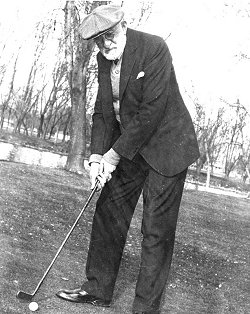
Heber J. Grant took the game seriously, and eventually became a fairly good, consistent golfer, though it has been said that he used only his irons. Elder Neal A. Maxwell remembered that, as a boy, he sometimes saw him playing at Nibley Park. He drove the ball straight, seldom sending it out of bounds. If he happened to hit it over the fence, however, he would reward the boy who recovered it with a quarter instead of the nickel other golfers might give.6
One of his golfing buddies was J. Spencer Cornwall, director of the Mormon Tabernacle choir. The two often teed off at Forest Dale at 6 a.m. then, after 9 holes of golf, headed for the Granite Stake Tabernacle where President Grant practiced his singing, accompanied by Brother Cornwall.7
President Grant tried to keep himself physically fit by exercising regularly each morning. Golf was a part of his regimen, as much for his mental and emotional well-being as for his physical. "There is no question about it," he wrote in his diary on April 2, 1930, "golf does take one's mind off everything else and refreshes the body and the mind."8
President Grant did not let golf interfere with his various responsibilities, however, though he often transacted Church business while playing golf with ecclesiastical and business associates.
He also had golfing friends outside of Utah, and not just in Santa Monica where he and other Church leaders spent much time. He was a long-time friend of Edgar A. Guest, prominent poet and writer, who lived in Detroit. Guest had a private golf course in his backyard and the two of them often played there.9
President Grant played golf with many other prominent people from around the nation. Perhaps the most famous was U.S. President Warren G. Harding. President Harding came to Utah in 1923, as part of a grand tour of the western United States. He arrived in Ogden aboard his train, the "Presidential Alaska Special," on June 26. There he addressed a huge welcoming crowd, then went on to Salt Lake City, where he spoke at Liberty Park.
Later that afternoon he partnered with President Grant at the Salt Lake Country Club for a round of golf against the club's pros. Utah's Senator Reed Smoot, an apostle and also an avid golfer, walked around with them and, according to him, "the two Presidents won."10 (Yes, I wonder, along with you, whether the pros were not just being easy on them.)
Golfers who tend to neglect their temple work, or non-golfers who may consider this old Scottish game to be an interference with spiritual life and responsibilities, take note! President Grant believed that golf contributed to enhancing his commitment to spiritual things, and particularly temple work. As he wrote in his diary on March 6, 1928,
Hyrum's family are doing fine, going to the temple every Friday. That is the day we have set to go. We had twenty-three a week ago last Friday and eighteen last Friday who had endowments and then stayed afterwards and did a lot of sealing. Last Friday we were sealed for twelve couples and had sixty-one children adopted. I went through the temple twenty-two times in January and February, which is a good record, and I can go away now for a week without feeling that I am not keeping up my record of going twice a week, which is what I have been trying to do for the year 1928.
I have become very deeply interested myself in temple work, and am annoyed that I neglected it for twenty or thirty or forty years when I could just as well have done some temple work during all that period. Taking time to play golf taught me a lesson that if you want to do a thing you can generally find time to do it. I thought it would be a hardship to go once a week, but we went a little more than once a week last year and have decided to go twice a week this year, and I have had no trouble at all in going more than twice a week while I have been home.11
Another apostle of that era, George F. Richards, was also a golf enthusiast and was apparently one of the few whose wife played with him. Bryant S. Hinckley wrote in 1932:
It is gratifying to know that during his busy and serious life he has never permitted the spirit of play to die in his heart. You may, on an early summer morning, see on the Municipal Golf Course a gallant, kindly looking, genial man, rather compactly built and neatly attired in golf togs, now seventy-one years of age; his wife, sixty-eight, the mother of fifteen children, trimly and appropriately dressed, both dignified but in a care-free spirit, playing golf with some of their children.12
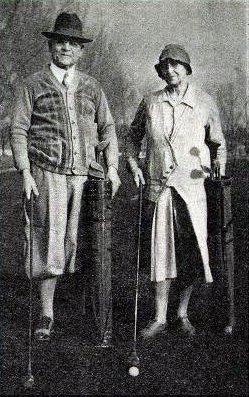
As much as President Grant and other Church leaders loved the game of golf, there was at least one apostle who was never converted. James E. Talmage's golf story is probably the most famous of any. I insert it here as it was told by his son, John R. Talmage:
In later years, James' long hours of work, unrelieved by periods of recreation, were cause for real concern among family, friends, and associates. President Heber J. Grant, for one, repeatedly urged Dr. Talmage to take up some form of sport, if only for its therapeutic value. Himself an enthusiastic golfer, President Grant tried to get his friend to try that sport, confident (as are all golfers) that if anyone were once thoroughly exposed to golf he would be captivated by its subtle but powerful attractions.
As President Grant's urgings increased in frequency and intensity, so did Dr. Talmage's demurrers on the grounds of lack of interest and lack of ability to master a complicated skill so late in life. President Grant was certain the skill could be mastered and that interest would automatically follow. Finally a compromise was reached, and a test agreed upon: James would give the game of golf an honest trial, and work at it until he was able to hit a drive which President Grant would rate as satisfactory, "a real golf shot."
"If you hit just one really good drive, nature will do the rest," President Grant assured his pupil-to-be. "You won't be able to resist the game after that."
It was agreed that James would make his own choice after he had acquired the skill to hit the specified shot. If he felt the fascination of the game, as President Grant was certain he would, he would take up golf and play with reasonable regularity. If, after giving the game a fair trial, James still felt no interest, President Grant would cease his efforts to get Dr. Talmage to play.
On an appointed day, the two, accompanied by a number of others of the General Authorities who played golf and who had joined the friendly argument on the side of President Grant, proceeded to Nibley Park for James' first session in what was expected to be a series of lessons.
James removed his coat and was shown how to grip the club and take his stance at the ball. The coordinated movements involved in making a golf stroke were carefully explained and then demonstrated by President Grant and by others. Finally it came James' turn to try it himself.
What followed astonished all those who watched, and probably James himself. Instead of missing the ball completely, or weakly pushing it a few feet along the grass, James somehow managed to strike the ball cleanly and with substantial force. It took off in a fine arc and with only a minimum amount of slice. Some who saw it described it later as "a truly magnificent drive," which was probably a considerable exaggeration. However, there was consensus that the ball went close to 200 yards and stayed in the fairway. It was a drive that would have gladdened the heart of any golfer short of the expert class, and it bordered on the phenomenal for a novice.
The spectators were momentarily struck dumb, then burst into enthusiastic applause.
"Congratulations," said President Grant, rushing forward, beaming, with outstretched hand. "That was a fine shot you will remember for the rest of your life."
"You mean that was a fully satisfactory golf shot?" James asked, cautiously.
"It certainly was!" said President Grant.
"Then I have fulfilled my part of the agreement?"
"You have -- and don't you feel the thrill of excitement? Now you'll be playing regularly. As a matter of fact, we can go into the clubhouse now and I will help you select a set of clubs."
"Thank you," said James, putting on his coat. "If I have carried out my part of the agreement, then I shall call on you to live up to yours. You promised that if I hit a satisfactory drive and did not feel the spontaneous desire to play, you would stop urging me to do so. Now I should like to get back to the office, where I have a great deal of work waiting."
So far as is known, James never again struck a golf ball, or made the attempt.13
The focus here has been on what was happening eight and nine decades ago, but it should not be surprising that modern Church leaders also play golf. I don't know who they all are, but I do know that there are several.
It is also a fact that for a time, in the 1950s and 1960s, the Church officially sponsored an annual all-Church golf tournament. Jessie L. Embry notes that for Church leaders who approved the tournament "golf was more than just a game. As Robert L. Simpson declared in 1968, 'The First Presidency is delighted with the golf tournament' because 'practice was key to success for golf' and in striving for 'the Celestial Kingdom.'"14
Well, I suppose it's clear that this column was written by a golf enthusiast, albeit one whose game is nothing to brag about. But let me end with a couple of notes from John Bytheway's delightful little book Golf: Lessons I Learned While Looking for My Ball.
In a kind of warning Bytheway wrote:
Elder Neal A Maxwell cautioned that we cannot "ride a golf cart into paradise." Noted LDS scholar Hugh Nibley, whose grandfather Charles W. Nibley donated the Nibley Park Golf Course to Salt Lake City, observed: "Like golf [politics] is a game into which a man can put his whole soul without dedicating his life to it, which can engage his total concentration for a few hours a week, and then be put in proper perspective, even held in contempt, for the rest of the time."
Yes, it is only a game, and must be put in proper perspective. Our personal progress shouldn't be put on hold in order to shave a few more strokes off our handicaps. It's a game, but it's a great game, and I'll be playing it again."15
And oh, yes, LDS golf enthusiasts like me can also take a bit of comfort in something else Bytheway said:
Will there be golf courses in the next life? Well, the scriptures do teach that "the course of the Lord is one eternal round." (1 Nephi 10:19)16

NOTES
1. From "Reminiscences Charles W. Nibley 1849-1931," published by his family, 1934. Accessed online at http://tillwegettoadam.net, then typing Reminiscences Charles W. Nibley into the search bar. Or simply Google "Reminiscences Charles W. Adams."
2. "Nibley Park Prepares to Celebrate 60th Birthday, Deseret News, May 19, 1982.
3. John J. Stewart, Life of Joseph Fielding Smith (Salt Lake City: Deseret Book, 1972), 198-99.
4. Manscill, Craig K. Manscill, Dennis A. Wright, Robert C. Freeman, Presidents of the Church: The Lives and Teachings of the Modern Prophets (Springville, Utah: Cedar Fort, Inc., 2008), 178.
5. Elder Robert E. Wells, "Seek Higher Flight Levels," fireside address at BYU, August 5, 1984. Accessed online at http://speeches.byu.edu/?act=viewitem&id=1114.
6. Neal A. Maxwell, One More Strain of Praise (Salt Lake City: Deseret Book, 1999), 97.
7. "Tabernacle's Renovation Part of Colorful History Spanning Some 60 Years," LDS Church News, October 14, 1989.
8. As quoted in Richard R. Cowan, "Advice From a Prophet: Take Time Out," BYU Studies 16:3 (Spring 1976), 415.
9. Bryant S. Hinckley, Heber J. Grant: Highlights in the Life of a Great Leader (Salt Lake City: Deseret Book, 1951), 220.
10. Michael K. Winder, Apostles and Prophets: The Story of America's Presidents and the LDS Church (American Fork, Utah, Covenant Communications, 2007), 222.
11. Heber J. Grant, "A Family Temple Night," Improvement Era, July 1944:425. In this article on the Editor's Page, President Grant was reminiscing from various letters and diary entries.
12. Bryant S. Hinckley, "George F. Richards," Improvement Era 35:6 (April 1932), 342.
13. John R Talmage, The Talmage Story: Life and Teachings of James E. Talmage -- Educator, Scientist, Apostle (Salt Lake City: Bookcraft, 1972), 226-28.
14. Jessie L. Embry, "Spiritualized Recreation: Mormon All-Church Athletic Tournaments and Dance Festivals." Provo, Utah: Charles Redd Center for Western Studies, 2008. Free online e-book at: http://reddcenter.byu.edu.
15. John Bytheway, Golf: Lessons I Learned While Looking for My Ball (Salt Lake City: Deseret Book, 2008), 180-81.
16. Ibid., 177.
| Copyright © 2024 by James B. Allen | Printed from NauvooTimes.com |